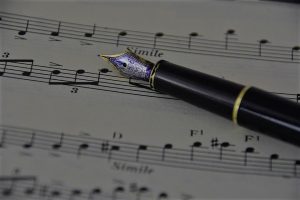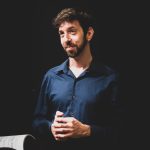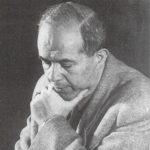 Since its inception, the Rubinstein Competition has commissioned works by Israeli composers which have premiered in the Competitions. For the 17th competition, the Competition management chose to present three Israeli composers: Yaron Gottfried with his composition “La Folia – Theme and Variations for Piano”, the late Marc Lavry (1903-1967) with his piece “Variations for Piano, Opus 350”, and Tal-Haim Samnon with “Memory and Variations”.
Since its inception, the Rubinstein Competition has commissioned works by Israeli composers which have premiered in the Competitions. For the 17th competition, the Competition management chose to present three Israeli composers: Yaron Gottfried with his composition “La Folia – Theme and Variations for Piano”, the late Marc Lavry (1903-1967) with his piece “Variations for Piano, Opus 350”, and Tal-Haim Samnon with “Memory and Variations”.
Competitors are obliged to include one of the three pieces in their recital program for the Competition, either in the first or in the second stage of the Competition.
Yaron Gottfried (b.1968)
 Yaron Gottfried – conductor, pianist and composer – is a multidisciplinary musician who bridges classical music
Yaron Gottfried – conductor, pianist and composer – is a multidisciplinary musician who bridges classical music
with contemporary music. Gottfried served as the musical director and chief conductor of the Netanya Kibbutz Chamber Orchestra in 2002-2013 and very successfully presented a unique artistic approach that combines musical styles and arts. Since October 2021, he serves as head of the music school at Ono Academic College.
His works, combining diverse musical worlds, are published by the prestigious international sheet music publishing house SIKORSKI, alongside composers such as Sofia Gubaidulina, Arvo Pärt, Shostakovich and others; they are appreciated and performed by many orchestras in Israel and around the world.
Gottfried performs with the best orchestras including: the Israel Philharmonic, the Israel Symphony Orchestra, the Florence Opera Orchestra Maggio Musicale, the WDR Cologne Radio Orchestra, the China Philharmonic, the Beijing Symphony, the Tbilisi Symphony, the Budapest Concert Orchestra, The Portland Chamber Orchestra and many others; this alongside many concert tours he has held in
China. He has artistically managed festivals and concert series, written arrangements for many concerts of leading Israeli artists with the Israel Philharmonic, including Idan Raichel, Yehoram Gaon, Danny Sanderson, Yasmin Levy and more.
Gottfried has won awards including: 2014 Prime Minister’s Prize Winner for Composers, the chosen artist of the Foundation for Cultural Excellence for the years 2003-2007, a member of the prestigious MacDowell Artist Center in the USA and winner of first prize for conducting as part of the Young Artist Week.
Gottfried founded the track for composition, arrangement and conducting at the Rimon School which he headed between 2013-2021.
As a jazz pianist he has performed with many well-known international artists including: Eddie Daniels, Eddie Gomez, Didier Lockwood, Dave Liebman, Ira Sullivan, Billy Hart, Georgie Fame, Randy Brecker, Jeff Berlin and many others.
Tal-Haim Samnon (b.1986)
 Tal-Haim Samnon was born in Tel Aviv. From the age of six, he studied with Hannah Shalgi at the Givatayim Conservatory. He graduated from the Thelma Yellin High School of the Arts and served as an outstanding musician in the IDF. Samnon completed his bachelor’s degree with honors with Professor Arie Vardi at the Buchmann-Mehta School of Music. Under the tutelage of Professor Evelyne Brancart, he completed his Artist Diploma degree at the Jacobs School of Music at Indiana University. From a young age he has performed concerts in Israel, Europe and the United States, and last October he gave a solo recital in Carnegie Hall, New York. He has played as a soloist with many orchestras, including the Israel Philharmonic conducted by Zubin Mehta.
Tal-Haim Samnon was born in Tel Aviv. From the age of six, he studied with Hannah Shalgi at the Givatayim Conservatory. He graduated from the Thelma Yellin High School of the Arts and served as an outstanding musician in the IDF. Samnon completed his bachelor’s degree with honors with Professor Arie Vardi at the Buchmann-Mehta School of Music. Under the tutelage of Professor Evelyne Brancart, he completed his Artist Diploma degree at the Jacobs School of Music at Indiana University. From a young age he has performed concerts in Israel, Europe and the United States, and last October he gave a solo recital in Carnegie Hall, New York. He has played as a soloist with many orchestras, including the Israel Philharmonic conducted by Zubin Mehta.
Apart from his work as a pianist, Samnon is also a composer and a writer. The literary-musical work DE GA, consisting of 16 songs that he wrote and composed, all linked by his poetic text, was performed twice and most recently at the Felicja Blumental Music Festival in the Zucker Hall of the Tel Aviv Bronfman Auditorium, following which his book was published. Samnon composed the song ”Eimat Harik” – horror vacui [Horror of the Empty Space] to words by Tsvia Litevsky, three songs from Omri Livnat’s book ”Malachi” ”Memory and Variations” for piano solo and ”The Book of Esther” for orchestra, two-voice choir and singers. Last May his piece “The Infinite Garden” for Orchestra, choir, singers and narrator based on a poem written by the late Ronen Israeli was performed in the annual concert of the Ronen Foundation. He orchestrated 8 songs of Fanny Hensel Mendelssohn. They were performed by soprano Chen Reiss with the Jewish Chamber Orchestra Munich and were recorded by Onyx.
La Folia has a long history. Its distinctive chords first developed out of the folk music of late 15th-Century Portugal, where it was played in popular festivals. Its name – ‘folly’ or ‘madness’ in Italian – refers to the frenzied way peasants twirled to the music.
The form captured the imagination of many great composers who have written masterpieces in this style from the Renaissance to the 20th century in a long Folia tradition. When I came to write my La Folia, I set myself the goal of creating a work which hopefully can take its place with the great existing works, continue the tradition and drive it onward, bringing in fresh new ideas that have not yet been put forward, in an original and personal way.
The work has 15 variations which reveal a gallery of musical styles, versatile rhythms and rich advanced harmonic language with timbres inspired by French, Russian, and Armenian music and contemporary jazz. The classical structure is deconstructed and expanded, sometimes using only a motif or fragment from the original theme while thematic relations are slowly formed between the variations.
Although the work was written during the Covid-19 lock down, it offers an optimistic view: the ’madness’ is mostly expressed by the freedom of the variations which have an improvisatory feel and flow. The last variation serves as a kind of summary relying on ideas from previous variations which brings the work to a satisfying and impressive ending.
“Memory and Variations” is a recollection of the piece “Melody with Variations” by the composer Paul Ben-Haim, which I played in my youth. It is a personal and nearly blind journey in which each variation describes a memory from my life.
The main theme “The Desert” describes the internal lyricism and emotion in the outer desolate space/body. The first variation is enlightenment and the void starting to fill up. The second variation describes the two extremes of the poetic in my life – the high versus the low. The third variation is an imitation of the harp and describes the proximity to the heavens, with high pitched sounds.
And from the Celestial we descend to the fourth variation – “Fire and Heroism”, the external or internal battle resulting in the body’s death. The fifth tragic variation mirrors the first theme, mourning for the death of the old. The sixth variation – “Toccata of Intrigue” – is the beginning of the soul’s renewal bubbling up out of a dark place. The seventh variation is the rebellion against everything that could have been good. The eighth variation is the bitter blind triumph, from which will remain a faint murmuring reminder of the main theme.
Marc Lavry (1903-1967)
 2023 marks the 120th anniversary of composer Marc Lavry’s birth. Lavry, a prolific Israeli composer, wrote over 400 compositions from operas, symphonies, chamber music to popular songs. He created a new musical style that became the foundation of Israeli music.
2023 marks the 120th anniversary of composer Marc Lavry’s birth. Lavry, a prolific Israeli composer, wrote over 400 compositions from operas, symphonies, chamber music to popular songs. He created a new musical style that became the foundation of Israeli music.
Practically every major event in the State of Israel between the years 1935-1967 was chronicled in music by Lavry, who was considered the National Composer.
A significant portion of his musical work documented events, illustrated landscapes and demonstrated the Israeli experience.
Lavry composed the first Israeli opera “Dan Hashomer” (Dan the Guard) and wrote the Israeli Defense Force’s first march Kitatenu Balayla Tsoedet (Our Squad Marches at Night). He co-founded the Kol Zion LaGola radio station and was the resident composer and conductor of many artistic institutes such as the Ohel Theater, the Israeli Folk Opera and more.
Lavry, a gifted pianist, wrote many compositions for piano including Concerto for Piano and Orchestra No. 1, Opus 201, and Concerto for Piano and Orchestra No. 2, Opus 210.
A late, mature piece, a culmination of Marc Lavry’s musical language and style. The theme is quintessential “Lavry” – it is melodious and uses harmonies typical of the composer.
Lavry treated the piano as an orchestra, which is evident in quite a number of his piano compositions, like the Variations for Piano Opus 350 and his two piano concerti. Starting with the theme, orchestral dimensions are revealed; wide harmonic ranges and massive doubling are used to create the maximum sonority from the instrument. The inner voices are rich with dense counterpoint using, at times, different rhythms or a fugal technique.
Each variation displays a unique character through color, texture and style. The piece switches between late romanticism, neoclassicism, impressionism, expressionism and even Jazz. The movements require precise technique and they challenge the pianist to move swiftly between registers. With his symphonic scope and gravity, Lavry is forever the master of improvisation and of dramatic characterization.



